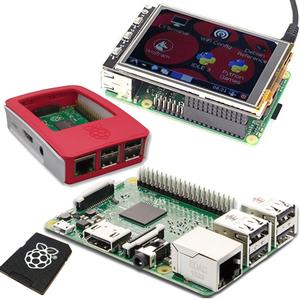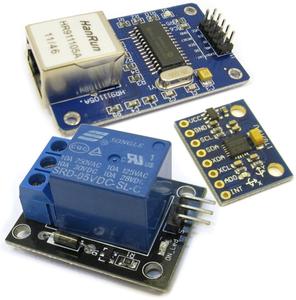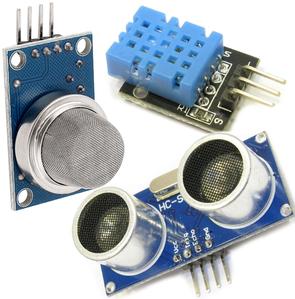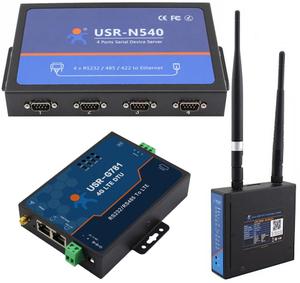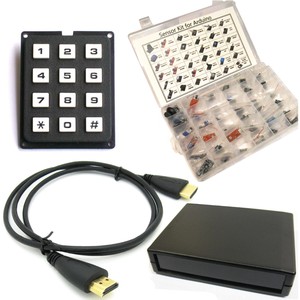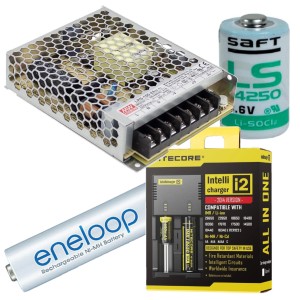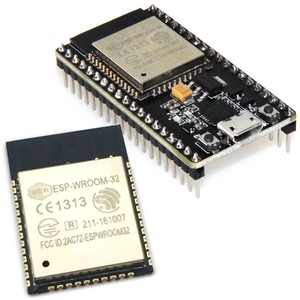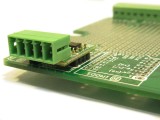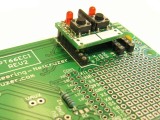iMod Modules are small breakout boards that provide interface or I/O functionality.They have two rows of pin headers spaced 0.7" (or 0.9" for some larger modules) apart, allowing them to be mounted on a breadboard or standard 0.1" grid prototype board. They are however designed to plug into iMod ports, that are located on many Modtronix and Netcruzer board - click here for a list of board with iMod ports.
They are available with different pin headers, allowing them to be used for many applications.
The module normally has press-fit connectors, and can be pressed into the pads on the iMod Port without any solder required. For a permanent connection, it could also be soldered. It is part of the Modtronix Presto Range of products. An iMod Module is used to add functionality to a target board. Some typical iMod Modules have interface drivers for adding an interface to a target board, like RS-232, RS-485, CAN Bus...
Description
All iMod Modules have two rows of connectors, a left and a right row. The signals on these connectors are pre-defined, allowing modules to be interchangeable. On the iMod Port, pin 1 (top most pin) of the left row will have a white marking around it. Most iMod Ports will have multiple left and right rows, situated next to each other. This allows iMod Modules of different widths to be mounted. The first picture below shows a typical iMod Port with two left rows, and a single right row. This allows iMod Modules of 0.6" and 0.7" to be mounted. If an iMod Port has multiple left or right rows, the adjacent pads are connected, as shown (with blue lines) in this picture.
A single iMod Module is defined to have a maximum row spacing of 0.7”, referred to as one module width. Modules can however be wider than one module width, other common module widths are 0.9”, 1.1” and 1.6”. Target boards can provide iMod Ports for fitting iMod modules. An iMod Port is very simple and cheap to implement, only two rows of 1.00mm pads 0.7” apart are required (with a 0.1”, that is 2.54mm, grid). Modules wider than 0.7” will normally take up two iMod Ports on the target board. Adjacent iMod Ports should be spaced 0.2” apart. To help inserting the iMod module correctly into the iMod Port, pin 1 of the left connector is marked (white band around pad) on the iMod Module and iMod Port, and should always be aligned!
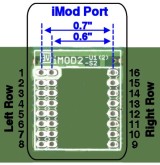
| 
| 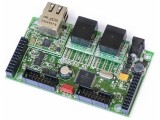
Some text |
| Click to enlarge |
iMod Port Pins
| The pins of an iMod Port are assigned standard signals: |
- Pin 1 is 0V
- Pins 3 and 4 is a serial port, like a USART, CAN Bus, USB....
- When used for a USART, 3 = Received Data, and 4 = Transmit Data
- When used for a CAN Bus, 3 = CAN Receive, and 4 = CAN Transmit (Initial pin assignment,might change)
- When used for USB, 3 = D-, and 4 = D+ (Initial pin assignment,might change)
- Pins 2, 5, 6, 7, 9 and 10 are general purpose I/O ports. Pins 2 and 5 are guaranteed to always be dedicated I/O pins. On some host boards, the other I/O pins might be shared between ports (if there are not enough available I/Os).
- Pins 12, 13 and 14 is a SPI or I2C serial port.
- When used as a SPI port, 12=SDO, 13=SDI and 14=SCK
- When used as a I2C port, 13=SDA and 14=SCL
- Pin 11 is Vsec, which is the secondary supply voltage. This will normally be 5V on a 3.3V board, and 5V on a 3.3V board.
- Pin 15 is Vcc. This is 3.3V or 5.0V, depending on the operating voltage of the host board.
- Pin 16 is Vaux. This is the unregulated input voltage of the host board. For example, if the host is supplied with a 12V DC supply, this will be 12V.
- On host boards with multiple iMod Ports, some I/O signals might be shared between ports. The first pins to be shared will be the ones at the back, pins 8 and 9. Next will be 7 and 10. It is thus recommended that iMod Modules first use the I/O signals at the front, in this order: pin 2, pin 5, pin 6, pin 7, pin 10, pin 8 and last pin 9.
| Left Row | Right Row |
|---|
| Pin | Description | Pin | Description |
|---|
| 1 | 0V: 0V of the power supply | 16 | Vaux: This is the unregulated input voltage of the host board. For example, if the host is supplied with a 12V DC supply, this will be 12V. | | 2 | IO or CS: General Purpose I/O. If a Chip Select signal is required, it is recommended to use this pin.
This port will always be available on all iMod ports! Is normally (not guaranteed) connected to RP pin of CPU.
-R[2] Option indicates it is a Relocatable I/O Pin of CPU. | 15 | Vcc: 3.3V. For 5V only boards, a jumper could set this pin to 5V!. | | 3 | RX - Serial Receive (or IO): Serial receive of the CPU (transmit of iMod module). Is connected to a RP(I) pin of CPU, so can be configured to be any available peripheral, like UART, CAN, SPI (SCL). At lease Relocatable Input Pin of CPU, maybe RP pin!
-R[3] Option indicates it is a Relocatable I/O Pin of CPU.
-RI[3] Option indicates it is a Relocatable Input pin of CPU. | 14 | CLK - SCK for SPI, or SCL for I2C: This is the serial clock output from the CPU. | | 4 | TX - Serial Transmit (or IO): Serial transmit of the CPU (receive of iMod module). Is always connected to a RP pin of CPU, so can be configured to be any available peripheral, like UART, CAN, SPI (SDA).
-R[4] Option indicates it is a Relocatable I/O Pin of CPU. | 13 | SDI - MISO(SDI) for SPI, or SDA for I2C: For SPI, this is the serial input of the CPU, and is connected to the SPI serial output of the circuit on the iMod module. | | 5 | IO or Int: General Purpose I/O, and possible Analog Input(1st priority). If an Interrupt signal is required, it is recommended to use this pin. Is often connected to a RP(I) pin of CPU, so can be configured to be any available peripheral, like UART, CAN, SPI...
-D[5] Option indicates it is a Digital I/O.
-A[5] Option indicates it is an Analog/Digital I/O.
-R[5] Option indicates it is a Relocatable I/O pin of CPU.
-I[5] Option indicates it is a Relocatable Input pin of CPU. | 12 | SDO - MOSI(SDO) for SPI (or IO): This is the SPI serial output from the CPU, and is connected to the SPI serial input of the circuit on the iMod module. | | 6 | IO: General Purpose I/O, and possible Analog Input (2nd priority).
-D[6] Option indicates it is a Digital I/O.
-A[5] Option indicates it is an Analog/Digital I/O.
-R[5] Option indicates it is a Relocatable I/O pin of CPU.
-I[5] Option indicates it is a Relocatable Input pin of CPU. | 11 | 5V: 5V. | | 7 | IO: General Purpose I/O, and possible Analog Input (3nd priority).
-D[7] Option indicates it is a Digital I/O.
-A[7] Option indicates it is an Analog/Digital I/O.
-R[7] Option indicates it is a Relocatable I/O pin of CPU.
-I[7] Option indicates it is a Relocatable Input pin of CPU. Combined 16/18 wide iMod port: For wide iMod port, is connected to iMod port 2 of unused iMod port. | 10 | IO: General Purpose I/O. Could be a slow I/O port! First use other I/O ports before using this one!
-D[6] Option indicates it is a Digital I/O. Combined 16/18 wide iMod port: For wide iMod port, is connected to iMod port 4 of unused iMod port. | | 8 | IO: General Purpose I/O. Could be a slow I/O port! First use other I/O ports before using this one!
-D[6] Option indicates it is a Digital I/O. Combined 16/18 wide iMod port: For wide iMod port, is connected to iMod port 3 of unused iMod port. | 9 | IO: General Purpose I/O. Could be a slow I/O port! First use other I/O ports before using this one!
-D[6] Option indicates it is a Digital I/O. Combined 16/18 wide iMod port: For wide iMod port, is connected to iMod port 5 of unused iMod port. |
|
 |
| |
Multiple left or right rows
Most iMod Ports will have multiple left and right rows, situated next to each other. This allows iMod Modules of different widths to be mounted. The pictures below show some typical iMod Ports with multiple left and/or right rows. This allows iMod Modules of different widths to be mounted.
If an iMod Port has multiple left or right rows, the adjacent pads are electrically connected. This is shown with blue lines in the pictures below.
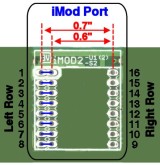
Shows iMod module with two left rows. This allows iMod Modules of 0.6" and 0.7" to be mounted. | 
Shows a SBC board with 3 iMod Ports. The first port is 0.9" wide, and the other two the standard 0.7". Because each port has multiple left and right rows, iMod Modules of different widths can be fitted. |
| Click to enlarge |

